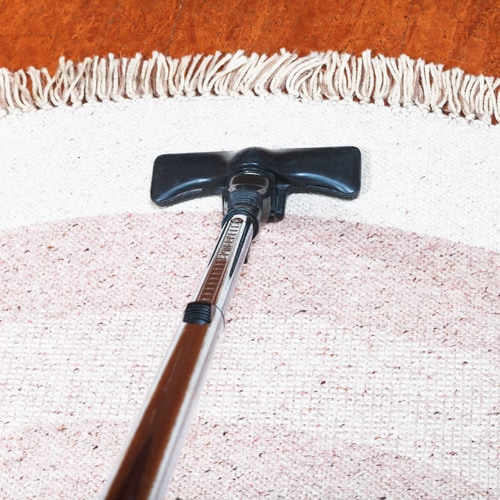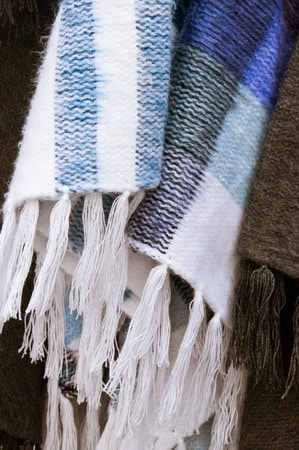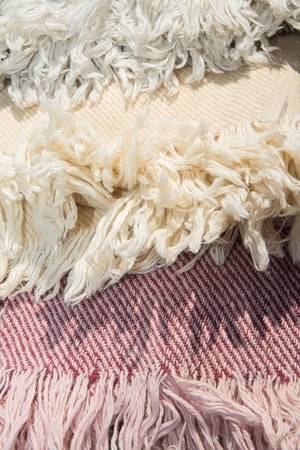There are times when a rug fringe cannot be cleaned. So, if you have tried to clean your rug’s fringe and haven’t accomplished much or if the fringe is too fragile to clean, then you will have to consider other solutions, such as the ones presented here!
Option #1: Cut them Shorter
If your fringe tassels are very long, there is no reason why you shouldn’t trim them a bit and make them shorter. That way, they won’t get in your way when you vacuum your rug or snagged by your shoes when you walk on them! The only issue with this option is that if you have a hand-made rug, which means the tassels comprise the foundation threads of your rug, you will eventually end up with a damaged rug and knots that start to unravel. Cut them too short and the knots will slide away. Undoubtedly, something like this devalues your rug for sure. So, you need to cut the fringe just as short to hold the end of the rug together, especially if you have a knotted fringe.
Of course, there are cases when the problem is the knots themselves. If the fringe tassel knots are higher than the other tassels, you press and pull them every time you walk on them, resulting in the cotton fringe tearing off at these knotted points. This can be particularly intense with high foot traffic and if the cotton fringe has gone through chemical whitening (bleaching) in the past. Again, the rug unravels. Sometimes, the best solution is to have an unknotted fringe, if the rug gets high traffic.
If this is your case, then you need to have a professional cut the fringe for you and take care of your rug. What expert rug cleaners and repairers do is untie the fringe, hand-secure the end with a stitch, be it an overcast or end stop, and then cut the tassels. The same principles apply to unknotted tassels. You only need to be certain that the end is properly secured, before the fringe is trimmed. Do this type of repair the right way, and rest assured that you won’t have to do it again. This is why you need someone that knows their job well; a professional that will do anything possible to save as many of the original knots as humanly possible. It is extremely crucial the one that will be performing this task for you has received proper training. This means that they have not only seen the type of stitch required to get the job done in a book, but also have been at weaving workshops and learned it hands-on. Trust us, any poorly executed endstop or overcast will get you into significantly more trouble that you had before.
Bottom line, the whole point when trying to trim fringes is to make them look better and protect the integrity of the weave.
Option #2: Hide Them
A smart way out of the previously discussed problem is to try to hide the fringe. This can be achieved if you secure its end. This will help keep the rug intact. Then, you can hide the tassels by having the edges wrapped in the wool.
Important Note: No matter how frustrated you are with your fringes, it is NEVER a good idea to cut them with a pair of scissors, because in most cases the rug comes apart. So, hiding the fringe will help you avoid causing structural damage to your favorite rug.
If you can’t wrap the edge because your tassels are just not short enough, you can fold them behind (under) the rug and make sure they are completely covered with a binding material. This is a common practice for many Tibetan rug owners. We all know that Nepalese/Tibetan rugs are made from high-quality wool and come in fantastic splashes of color or natural tones. Sometimes though, the very white fringe they usually come with is not much appealing and seem to not frame the rug well, so retailers hide the fringe with materials! An excellent option to keep the rug intact and give your rug the look you want.
Hiding Method
A very easy and cost-effective way is to tap the fringe under the rug (the back side). Masking tape is perfect for this type of job as it leaves considerably less adhesive residue than any other option (i.e. clear packing tape).
Tip: If you have used clear packing tape, just be extra careful when you remove it from the weakened or whitened fringe or you will tear the tassels away, capsizing every effort you have made to protect them.
Option #3: Replace Them
Those that know about rugs simply hate fake fringes, probably because the majority of rugs have had fringe added to them by sewing or surging machines, which are clear trouble makers and damage hand-woven rugs. This is why it is important hand-woven rugs are hand-repaired. A skilled professional can make sure no foundation damage is caused. They can slide the needles around (rather than through) wefts and warps, unlike sewing machines that usually massacre and devalue rugs.
Now, replacing fringe demands a trained eye because what may seem like an excellent job done to you, could be deficient and you may as well end up with a rug torn along its ends and sides. This is an irreversible damage that cannot be undone, so you have to know which rug repairing companies do hand-stitching and not use machines to work on hand-woven rugs. Else it would be like using duct tape to fix holes!
All in all, it is much more preferable to use prefabricated fringe (which can be any color or style you wish) to cover up the old one by hand than anything else. That aside, prefabricated fringe can be knotted and threaded in a way that would be difficult to distinguish it from its original fringe. Again, it requires expertise.
Or you could go for knotted fringe when your rug’s fridge has worn away so that you can protect the original and give your rug the look you want, which is by far a better and more affordable option than attempting to reweave the tassels. And, if it gets filthy, just replace it!
Finally, if you don’t like prefabricated fringe, you can also restring the tassels. Ask us for more information!
If your fringe can be cleaned, you are oh-so-lucky! Check out how you can deal with pet poodles and how often you can clean your favorite rug!







